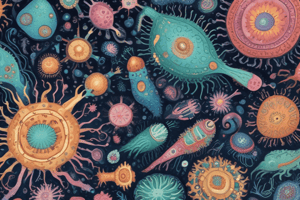Podcast
Questions and Answers
What is the primary function of food vacuoles in protozoa?
What is the primary function of food vacuoles in protozoa?
Which of the following is a characteristic of Sarcodina?
Which of the following is a characteristic of Sarcodina?
What is the primary mode of reproduction in most protozoa?
What is the primary mode of reproduction in most protozoa?
Which group of protozoa is known for forming spores?
Which group of protozoa is known for forming spores?
Signup and view all the answers
What is the role of protozoa in decomposing organic matter?
What is the role of protozoa in decomposing organic matter?
Signup and view all the answers
Which of the following is an example of a disease caused by a protozoan parasite?
Which of the following is an example of a disease caused by a protozoan parasite?
Signup and view all the answers
What is the term for the exchange of genetic material between two protozoa?
What is the term for the exchange of genetic material between two protozoa?
Signup and view all the answers
Which of the following is a characteristic of Mastigophora?
Which of the following is a characteristic of Mastigophora?
Signup and view all the answers
What is the term for the movement of protozoa using cilia?
What is the term for the movement of protozoa using cilia?
Signup and view all the answers
Which of the following is NOT a characteristic of protozoa?
Which of the following is NOT a characteristic of protozoa?
Signup and view all the answers
Study Notes
Characteristics of Protozoa
- Eukaryotic, single-celled microorganisms
- Typically microscopic, ranging from 10-500 μm in size
- Can be found in almost every environment, including freshwater, saltwater, and soil
- Most protozoa are motile, using structures such as cilia, flagella, or pseudopodia to move
Nutrition and Digestion
- Heterotrophic, obtaining energy by consuming other organisms or organic matter
- Some protozoa are predators, capturing and ingesting prey whole
- Others are saprotrophic, breaking down organic matter externally and absorbing the resulting nutrients
- Digestion occurs within food vacuoles, where enzymes break down ingested material
Reproduction and Life Cycles
- Asexual reproduction: binary fission, budding, or fragmentation
- Sexual reproduction: conjugation, involving the exchange of genetic material between two individuals
- Some protozoa have complex life cycles, involving multiple stages and hosts (e.g., Plasmodium, which causes malaria)
Classification and Diversity
- Protozoa are a polyphyletic group, meaning they do not share a common ancestor
- Traditionally divided into four main groups: Sarcodina (amoebas), Mastigophora (flagellates), Ciliophora (ciliates), and Sporozoa (spore-forming protozoa)
- Over 30,000 known species, with many more thought to exist
Ecological Roles
- Decomposers: breaking down organic matter and recycling nutrients
- Predators: regulating populations of bacteria, algae, and other small organisms
- Parasites: causing disease in animals, including humans (e.g., malaria, giardiasis)
- Food sources: serving as a food source for other organisms, such as zooplankton and fish
Characteristics of Protozoa
- Protozoa are eukaryotic, single-celled microorganisms
- They are typically microscopic, ranging from 10-500 μm in size
- Protozoa can be found in almost every environment, including freshwater, saltwater, and soil
- Most protozoa are motile, using structures such as cilia, flagella, or pseudopodia to move
Nutrition and Digestion
- Protozoa are heterotrophic, obtaining energy by consuming other organisms or organic matter
- Some protozoa are predators, capturing and ingesting prey whole
- Others are saprotrophic, breaking down organic matter externally and absorbing the resulting nutrients
- Digestion occurs within food vacuoles, where enzymes break down ingested material
Reproduction and Life Cycles
- Protozoa can reproduce asexually through binary fission, budding, or fragmentation
- Sexual reproduction involves conjugation, where genetic material is exchanged between two individuals
- Some protozoa have complex life cycles, involving multiple stages and hosts (e.g., Plasmodium, which causes malaria)
Classification and Diversity
- Protozoa are a polyphyletic group, meaning they do not share a common ancestor
- They are traditionally divided into four main groups: Sarcodina (amoebas), Mastigophora (flagellates), Ciliophora (ciliates), and Sporozoa (spore-forming protozoa)
- There are over 30,000 known species of protozoa, with many more thought to exist
Ecological Roles
- Protozoa play a crucial role in decomposition, breaking down organic matter and recycling nutrients
- They act as predators, regulating populations of bacteria, algae, and other small organisms
- Some protozoa are parasites, causing disease in animals, including humans (e.g., malaria, giardiasis)
- Protozoa also serve as a food source for other organisms, such as zooplankton and fish
Studying That Suits You
Use AI to generate personalized quizzes and flashcards to suit your learning preferences.
Description
Explore the characteristics of protozoa, including their structure, size, and habitat. Learn about their nutrition and digestion processes, and how they obtain energy.




